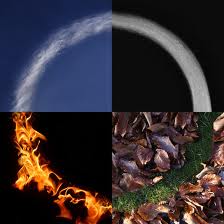 We had our Sunday Introduction to Meditation Class at Yoga Bliss yesterday. We’ve been working with the four foundations of mindfulness: awareness of the body, feeling tone, thoughts, emotions and then all phenomena. We drew our practice inspiration from B. Alan Wallace’s Minding Closely: The Four Applications of Mindfulness. We included two practice periods and a walking meditation.
We had our Sunday Introduction to Meditation Class at Yoga Bliss yesterday. We’ve been working with the four foundations of mindfulness: awareness of the body, feeling tone, thoughts, emotions and then all phenomena. We drew our practice inspiration from B. Alan Wallace’s Minding Closely: The Four Applications of Mindfulness. We included two practice periods and a walking meditation.
We used Alan’s guided meditation On the Elements: earth, water, fire and air. We directed our attention to the tactile experiences of solidity, fluidity, relative heat and coolness and lightness and movement. In studying these experiences we investigated whether they were stable and unchanging. Alan asks:
As you attend to all the subtle and coarse movements within the field, is there anything that suggests ownership? Or are these merely emergences of motion, arising within a tactile field to which you have privileged access?
This practice involved distinguishing between the direct experience of sensation from the overlays or projections of experience we create with our minds. It made me aware of how reflexively I create experience rather than entering it directly. It also revealed how often I label experience as “mine” as in referring to “my pain” or “my condition.” When I can release this self-identification it is easier to observe experience change: its impermanent nature is revealed.
In his book, Alan recommends the practice of observing another person’s body. He suggests that we “observe what is being presented. . . . Surgically peel away the layers of conceptual projection, transference, assumptions, likes, dislikes and attend to what is actually being presented.” In this way, we use inference and empathy. Alan writes that by drawing on memories of our own body and using inference we can create a basis for empathy in wisdom. By quieting the mind and releasing any expectations, memories and desires we can truly attend to someone else. We can observe fresh appearances as they emerge from moment to moment.
How often do we really attend to ourselves or another person in this way? How can we let go of “looking for something” and merely observe what emerges? This is the ground of uncertainty and “not knowing” that I stay so busy avoiding. This practice has helped prepare me, minute by timeless minute, to enter this ground. I’ve recently been forced to live with a lot of uncertainty which nothing in “my power” can dispel. Yet, I’m only stuck when I struggle to keep things from changing.
Your presence certainly makes the ground of uncertainty a shared ground and somehow more habitable.
